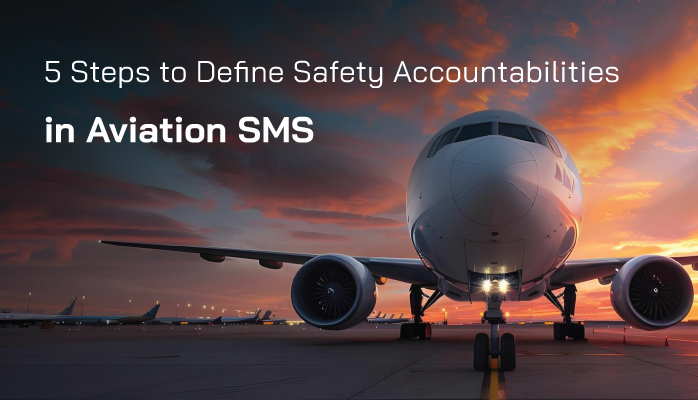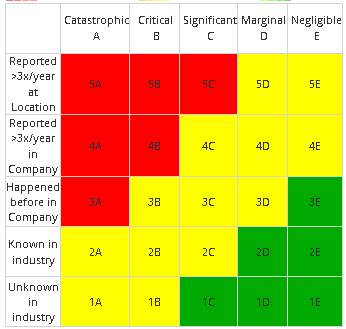Org Charts Help to Define Accountabilities in Aviation SMS

Safety accountabilities in aviation safety management systems (SMS) implementations outline the bureaucratic structure of organizational safety expectations. Defining accountabilities has the ultimate goal of clearly communicating:
- What levels of responsibility are defined in the aviation SMS;
- Different levels of responsibility for each role; and
- Which roles have the authority to make certain safety decisions?
Safety org-charts are a good place to start when identifying and defining safety accountabilities. They provide the basic structure and flow of safety information in your aviation SMS. Ultimately, an accountability map will look like a much more complex org chart.
Related Articles on Org Charts in Aviation SMS
- How to Create an Org Chart for Aviation Safety Programs
- 4 Important Reasons to Use Org Charts in Aviation SMS
- How to Create SMS Org Chart in Aviation Safety Management
Safety Accountabilities Should Be Regularly Reviewed in Aviation SMS
Safety accountabilities should be periodically reviewed and updated in aviation SMS implementations. By review, we should not simply consider "management review" for relevancy and accuracy, but also stakeholder review. Stakeholder review commonly occurs during the initial SMS training process. During the initial SMS training, employees are trained on:
- what is an aviation SMS;
- what is their role in the SMS;
- which management protections, if any, are afforded to employees for self-reporting;
- the SMS aims to improve safety and not to attribute blame;
- management expectations of them regarding the SMS.
Organizations must update safety accountabilities because the following factors can greatly influence the effectiveness of existing accountabilities:
- Employee/Management/Executive changes;
- Growth of company;
- Changes in policy, procedures, and scope of operations; and
- Inadequacies to current responsibilities.
Best practices are that safety accountabilities are reviewed by management on an annual basis. Safety professionals will also more frequently communicate these safety accountabilities during safety promotion campaigns, such as:
- Safety newsletters;
- Safety posters and bulletins;
- Safety surveys; and
- Safety messages on the electronic bulletin board.
Fortunately, creating and updating accountabilities is not very difficult to do. Here are 5 steps you can use to define accountabilities in aviation SMS implementations.
Step 1: Identity the Accountable Executive Responsible for SMS

It’s a common misconception in aviation SMS implementations that the aviation safety officer is ultimately responsible for the implementation and maintenance of the SMS. In fact, it is an appointed accountable executive who is responsible for the SMS.
The accountable executive is ultimately responsible for:
- The successful implementation of the SMS;
- Monitoring implementation progress of SMS;
- Safety decisions;
- SMS budgetary concerns; and
- The safety culture exhibited by employees and management.
In organizations, there may be multiple executives who can be designated as the accountable safety executive, such as a CEO, COO, CBDO, etc. Choosing an accountable executive is simply a matter of identifying:
- Which executive is most willing/able to act as chief safety executive; and
- Which executive’s existing responsibilities align the most closely with safety operations?
It’s not always clear which executive is the best fit. No executive may want to be accountable for a failure resulting from improper SMS implementation. These are problems with no easy answers, and it will be up to the executive team to be comfortable with the final decision.
Related Articles on Safety Accountabilities in Aviation SMS
- Distinguishing Between Responsibility, Authority, and Accountability in Your Aviation SMS
- 3 Scenarios for Accountable Executives to Minimize Risk to Aviation SMS
- Best Practices for Safety Accountabilities in Aviation SMS - With Resources
Step 2: Define Hierarchy Lines of Safety Accountability
Developing the hierarchy lines of accountability is a critical step in the overall process of defining safety accountability in aviation SMS. Hierarchy lines should establish lines of authority for safety accountability from positions with the least accountability to the most accountability.
They help answer questions:
- To whom does each position in the company answer?
- What is the flow of communication for decision-making in the company?
- To whom does each position in the company look for guidance?
Naturally, the hierarchy will form a pyramid shape, ending with the accountable executive at the top. Each “point” in the hierarchy lines can be a position with a singular person, such as a safety manager, or a position that has numerous employees, such as “trainees.”
Hierarchy of safety authority diagrams should also periodically be revised. For example:
- An experienced upper manager leaves the company;
- The experienced manager is replaced by someone outside the company;
- It would be logical to modify the safety hierarchy to replace the new upper manager’s position with a position that has more experience.
It’s also extremely important to point out that what we are talking about is a safety hierarchy and not the company chain of command hierarchy. While the company hierarchy and safety hierarchy of accountability will look similar, the safety hierarchy is specifically tailored to safety
- communications,
- authority and
- responsibility.
Step 3: Identify Accountabilities of Each Member/Role
Once the hierarchy lines of safety accountability have been established, you need to establish what safety need(s) each role is responsible for. Safety needs are any actions/behaviors a company needs in their aviation SMS to drive safety performance. Some examples:
- Hazard identification;
- Hazard risk analysis;
- Managing corrective actions and preventative actions (CPAs);
- Review risk controls;
- Accept risk for identified and risk-assessed hazards;
- Creating new procedures; and
- Reviewing safety checklists.
A real list will be considerably longer than this. These two useful ways to establish accountabilities of each role:
- Make a comprehensive list of all safety needs and then assign each safety need to position(s) in the company; or
- Analyze each position in the hierarchy and establish which needs it can best service; and
- Create a “dictionary” or “index” of each responsibility and its description.
This activity is extremely important because it shows everyone in your company which specific needs they are responsible for. This step should be taken with great care and consideration.
Related Aviation SMS Articles
- Difference Between Hazards, Risks & Control Measures in Aviation SMS
- How to Identify Hazards and Assess Risks in Aviation SMS - With Free Resources
- Difference Between Hazard Risk Assessment and Hazard Risk Analysis
Step 4: Document and Communicate Safety Responsibilities
By this point, the hard work is finished. Now you simply need to:
- Make an appealing diagram of your safety accountability hierarchy lines and the corresponding responsibilities;
- Place the diagram and responsibilities in a visible, easy-to-access place; and
- Communicate to all employees that company accountabilities have been created.
A great way to have employees involved in this process is to hold department-specific safety meetings where each department can discuss the completed accountability diagram and give their input. Managers can then meet, discuss the findings, and make changes.
Step 5: Define Management Authority to Make Safety Decisions

A final step needed to completely define accountabilities in aviation SMS implementations is to decide:
- What are the important decisions that will be made in your company; and
- Which positions in the hierarchy have the authority to make them.
For example, creating goals and deadlines for aviation SMS implementation are important decisions as they will set the tone for the management of change in the company. Should the accountable executive make that decision? Should the safety manager?
There are a small handful of decisions like this that need to be assigned to roles in the company. An important element that should be dealt with regards risk acceptance authority. Which managers or roles have risk acceptance authority based on risk assessments during the risk management process? This is not a "one-size-fits-all" decision, as each company is different, as is their risk appetite.
As an example of risk acceptance authority, your safety policy may state that whenever a safety issue has been risk assessed as "Intolerable" or "Unacceptable," then operations must stop until authorized by the accountable executive. "Intolerable" and "Unacceptable" risk assessments are typically displayed as red cells in the risk matrix.
Another example of risk acceptance authority may be that operational department heads can accept the risk for safety issues risk assessed as "Mitigatable" or "Acceptable with Mitigations." These risk assessments are typically reflected by a yellow cell in the risk matrix.
Related Aviation Risk Management Articles
- Difference Between Reactive, Predictive and Proactive Risk Management in Aviation SMS
- What Is the Process of Risk Management in Aviation SMS
- 3 Main Components of Aviation Risk Management
Final Thought: Completing the Requirement
You will know that the safety accountabilities requirement in the Safety Policy element of the Four Pillars of aviation SMS is satisfied when:
- There are clear lines of accountability both as documented and in practice;
- Clear evidence that safety management principles have penetrated the everyday working culture; and
- Individual employees understand and sign for their accountabilities.
A great way to get started with defining your safety accountabilities is to download our free template for safety accountability and give yourself a head start:
Tracking management review and employee review of safety accountabilities can be facilitated by using aviation SMS software. Since 2007, SMS Pro has been working with aviation service providers. SMS Pro provides a hosted SMS data management that reduces risk to aviation operators.
To learn how you can benefit from an SMS database, please watch these short demo videos.
Last updated May 2025.







